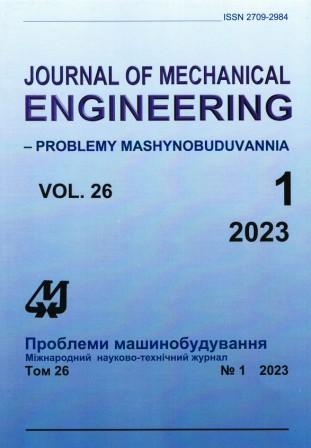Аналіз напруженого стану шару з двома циліндричними врізаними опорами
Аннотация
Досліджується напружений стан однорідного ізотропного шару при дії просторового статичного зовнішнього навантаження. Дві кругові циліндричні опори врізані в тіло шару паралельно його межам. Опори та тіло шару жорстко спряжені між собою. Просторова задача теорії пружності розв’язується за допомогою аналітико-чисельного узагальненого методу Фур’є. Шар розглядається в декартовій системі координат, опори – у локальних циліндричних. На верхній та нижній поверхнях шару задані напруження. Опори розглядаються у вигляді циліндричних порожнин у шарі із заданими на їх поверхнях нульовими переміщеннями. Задовольняючи граничним умовам на верхній і нижній поверхнях шару, а також на циліндричних поверхнях порожнин, отримано системи нескінченних інтегро-алгебраїчних рівнянь, які в подальшому зведені до лінійних алгебраїчних. Нескінченна система розв’язується методом редукції. У чисельних дослідженнях проаналізовано параметри інтегрування коливних функцій, розв’язані задачі при різних відстанях між опорами. Одиничне навантаження у вигляді швидко спадаючої функції прикладено на верхній межі між опорами. Для цих випадків проведено аналіз напруженого стану на поверхнях шару між опорами та на циліндричних поверхнях, що контактують з опорами. Чисельний аналіз показав, що при збільшенні відстані між опорами зростають напруження σx на нижній та верхній поверхнях шару й напруження τρφ на поверхнях порожнин. Використання аналітико-чисельного методу дало можливість отримати результат із точністю 10-4 для значень напружень від 0 до 1 при порядку системи рівнянь m=6. При збільшенні порядку системи точність виконання граничних умов зростатиме. Представлене аналітико-чисельне розв’язання може використовуватися для високоточного визначення напружено-деформованого стану представленого типу задач, а також як еталонне для задач, що базуються на чисельних методах.
Загрузки
Опубликован
Выпуск
Раздел
Лицензия
Copyright (c) 2023 В. Ю. Мірошніков, О. Б. Савін, М. М. Гребенніков, В. Ф. Деменко

Это произведение доступно по лицензии Creative Commons «Attribution-NoDerivatives» («Атрибуция — Без производных произведений») 4.0 Всемирная.
Авторы, публикующиеся в этом журнале, соглашаются со следующими условиями:
- Авторы оставляют за собой право на авторство своей работы и передают журналу право первой публикации этой работы на условиях лицензионного договора (соглашения).
- Авторы имеют право заключать самостоятельно дополнительные договора (соглашения) о неэксклюзивном распространении работы в том виде, в котором она была опубликована этим журналом (например, размещать работу в электронном хранилище учреждения или публиковать в составе монографии), при условии сохранения ссылки на первую публикацию работы в этом журнале.
- Политика журнала позволяет размещение авторами в сети Интернет (например, в хранилищах учреждения или на персональных веб-сайтах) рукописи работы, как до подачи этой рукописи в редакцию, так и во время ее редакционной обработки, поскольку это способствует возникновению продуктивной научной дискуссии и позитивно отражается на оперативности и динамике цитирования опубликованной работы (см. The Effect of Open Access).

